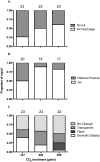Projected near-future CO2 levels increase activity and alter defensive behaviours in the tropical squid Idiosepius pygmaeus
- PMID: 25326517
- PMCID: PMC4232764
- DOI: 10.1242/bio.20149894
Projected near-future CO2 levels increase activity and alter defensive behaviours in the tropical squid Idiosepius pygmaeus
Abstract
Carbon dioxide (CO2) levels projected to occur in the oceans by the end of this century cause a range of behavioural effects in fish, but whether other highly active marine organisms, such as cephalopods, are similarly affected is unknown. We tested the effects of projected future CO2 levels (626 and 956 µatm) on the behaviour of male two-toned pygmy squid, Idiosepius pygmaeus. Exposure to elevated CO2 increased the number of active individuals by 19-25% and increased movement (number of line-crosses) by nearly 3 times compared to squid at present-day CO2. Squid vigilance and defensive behaviours were also altered by elevated CO2 with >80% of individuals choosing jet escape responses over defensive arm postures in response to a visual startle stimulus, compared with 50% choosing jet escape responses at control CO2. In addition, more escape responses were chosen over threat behaviours in body pattern displays at elevated CO2 and individuals were more than twice as likely to use ink as a defence strategy at 956 µatm CO2, compared with controls. Increased activity could lead to adverse effects on energy budgets as well as increasing visibility to predators. A tendency to respond to a stimulus with escape behaviours could increase survival, but may also be energetically costly and could potentially lead to more chases by predators compared with individuals that use defensive postures. These results demonstrate that projected future ocean acidification affects the behaviours of a tropical squid species.
Keywords: Anti-predator behaviour; Avoidance; Cephalopod; Escape; Ocean acidification; Startle response.
© 2014. Published by The Company of Biologists Ltd.
Conflict of interest statement
Figures




Similar articles
-
Predatory strategies and behaviours in cephalopods are altered by elevated CO2.Glob Chang Biol. 2018 Jun;24(6):2585-2596. doi: 10.1111/gcb.14098. Epub 2018 Mar 23. Glob Chang Biol. 2018. PMID: 29460508
-
Aerobic performance of two tropical cephalopod species unaltered by prolonged exposure to projected future carbon dioxide levels.Conserv Physiol. 2019 Jun 7;7(1):coz024. doi: 10.1093/conphys/coz024. eCollection 2019. Conserv Physiol. 2019. PMID: 31198560 Free PMC article.
-
The role of ligand-gated chloride channels in behavioural alterations at elevated CO2 in a cephalopod.J Exp Biol. 2021 Jul 1;224(13):jeb242335. doi: 10.1242/jeb.242335. Epub 2021 Jul 8. J Exp Biol. 2021. PMID: 34100547
-
Climate change and ocean acidification effects on seagrasses and marine macroalgae.Glob Chang Biol. 2013 Jan;19(1):103-32. doi: 10.1111/j.1365-2486.2012.02791.x. Epub 2012 Sep 24. Glob Chang Biol. 2013. PMID: 23504724 Review.
-
Physiological impacts of elevated carbon dioxide and ocean acidification on fish.Am J Physiol Regul Integr Comp Physiol. 2014 Nov 1;307(9):R1061-84. doi: 10.1152/ajpregu.00064.2014. Epub 2014 Aug 27. Am J Physiol Regul Integr Comp Physiol. 2014. PMID: 25163920 Review.
Cited by
-
Cuttlefish Early Development and Behavior Under Future High CO2 Conditions.Front Physiol. 2019 Jul 26;10:975. doi: 10.3389/fphys.2019.00975. eCollection 2019. Front Physiol. 2019. PMID: 31404314 Free PMC article.
-
Cuttlefish Buoyancy in Response to Food Availability and Ocean Acidification.Biology (Basel). 2020 Jul 1;9(7):147. doi: 10.3390/biology9070147. Biology (Basel). 2020. PMID: 32630264 Free PMC article.
-
Ocean warming and acidification alter the behavioral response to flow of the sea urchin Paracentrotus lividus.Ecol Evol. 2019 Oct 17;9(21):12128-12143. doi: 10.1002/ece3.5678. eCollection 2019 Nov. Ecol Evol. 2019. PMID: 31832148 Free PMC article.
-
Ocean acidification alters predator behaviour and reduces predation rate.Biol Lett. 2017 Feb;13(2):20160797. doi: 10.1098/rsbl.2016.0797. Biol Lett. 2017. PMID: 28148828 Free PMC article.
-
Near-future ocean warming and acidification alter foraging behaviour, locomotion, and metabolic rate in a keystone marine mollusc.Sci Rep. 2020 Mar 25;10(1):5461. doi: 10.1038/s41598-020-62304-4. Sci Rep. 2020. PMID: 32214174 Free PMC article.
References
-
- Boletzky S. v., Nishiguchi M. K., Nabhitabhata J., Nugranad J. (2005). Idiosepius: ecology, biology and biogeography of a mini-maximalist. Phuket Mar. Biol. Cent. Res. Bull. 66, 11–22.
-
- Chivers D. P., McCormick M. I., Nilsson G. E., Munday P. L., Watson S. A., Meekan M. G., Mitchell M. D., Corkill K. C., Ferrari M. C. O. (2014). Impaired learning of predators and lower prey survival under elevated CO2: a consequence of neurotransmitter interference. Glob. Chang. Biol. 20, 515–522 10.1111/gcb.12291 - DOI - PubMed
-
- Collins M., Knutti R., Arblaster J., Dufrensne J.-L., Fichefet T., Friedlingstein P., Gao X., Gutowski W. J., Johns T., Krinner G. et al. (2013). Long-term climate change: projections, commitments and irreversibility. Climate Change 2013: the Physical Science Basis: Working Group I Contribution to the Fifth Assessment Report of the Intergovernmental Panel on Climate Change Stocker T F, Qin D, Plattner G-K, Tignor M, Allen S K, Boschung J, Nauels A, Xia Y, Bex V, Midgley P M, edCambridge; New York, NY: Cambridge University Press.
LinkOut - more resources
Full Text Sources
Other Literature Sources
Research Materials
Miscellaneous

